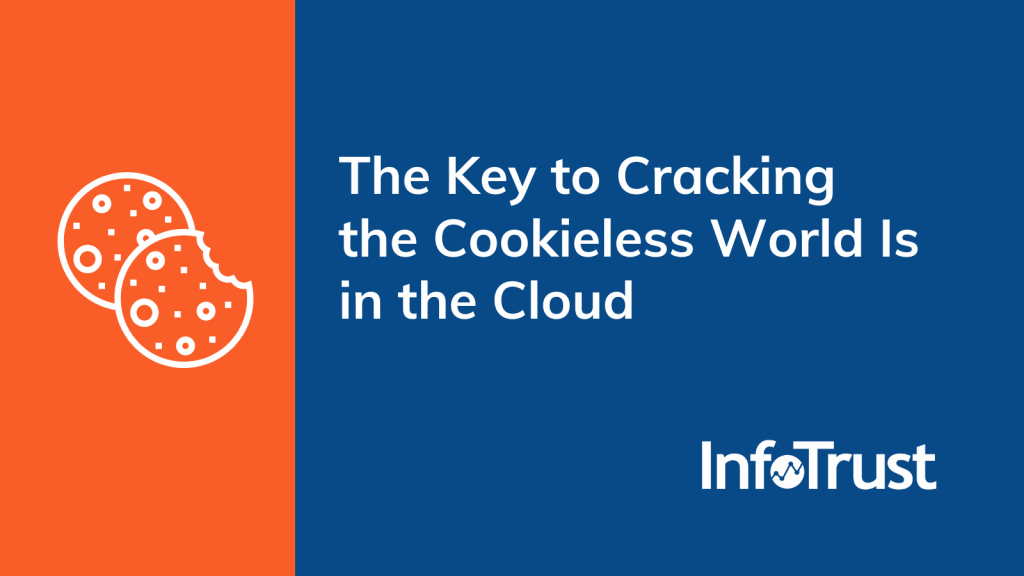In the past, when a customer visited your site, looked at a product, and navigated away, even if they never explicitly identified themselves, you could target them with ads for days, reminding them just how much that product could improve their lives.
With this advertising model, marketers could rely on third-party tools that collected consumer information using third-party cookies. The consumer didn’t have to consent in order for an organization to learn about their preferences and habits. But this cookie-centric world is changing rapidly. Government regulations like the California Consumer Privacy Act (CCPA) and Europe’s General Data Protection Regulation (GDPR) have placed limits on data processing, and major technology changes are in the works. Google has expressed its intention to phase out support for third-party cookies in Chrome browsers by 2023, and Safari effectively stopped support of third-party cookies with their introduction of Intelligent Tracking Prevention in 2019.
These changes mean that, soon, organizations won’t be able to leverage third-party cookies, and the impact on digital business will be huge. So what’s left? First-party data is the way of the future, and organizations need to adapt quickly if they want to stay ahead of the revolution.
In this new cookieless world, one of the most important tools at organizations’ disposal is the cloud. Below, I explain why the cloud will be essential for weathering privacy changes and reveal how your organization can use the cloud to make the most of first-party data.
First-Party Data
Before we jump into the powers of the cloud, it’s critical to understand some major components of first-party data. Every organization needs to consider these three things before they start seeking solutions:
- Strategy: What is your strategy around first-party data? What are you doing, not only to collect it, but to make the best use of it? The industry has relied on 3rd party data collectors to provide business insights in real time. Soon, we will only be able to rely on our own first party data to uncover these insights. The responsibility on data readiness now lies within your first data systems.
- Integration: Your consumer data should not live across two, three, or four different cloud environments. When data is siloed, it minimizes your ability to act on that information and understand the big picture. For example, let’s say a consumer requests their information under CCPA. If your data lives in two or three different systems, it will take much longer (and cost more) for you to make that data available to the consumer and act in accordance with the regulations. Regardless of whether your organization prefers Microsoft, Google, Amazon, or some other cloud solution, make sure your consumer data is consistently integrated within one of those Cloud Solutions.
- Modeling in a cloud environment: Once your data is integrated into a single cloud environment, it becomes much easier to run advanced analysis on that data. Keep in mind that due to consent requirements, you’re going to have access to a lot less data. And because you have access to less data, you will need to become much better in data science and using your own data for modeling different scenarios.
In other words, the cloud itself isn’t the key to cracking the cookieless world. The key is having an integrated cloud environment in which you can create sophisticated analytical models to better understand your target customers.
Audience Segmentation and Targeting
When you talk about customer acquisition, it’s fairly easy to say, “We want more first-party data.” But is that really the best strategy? What if I tell you that I can get 100 people to your website, and in order for you to capture everyone’s email, all you need to do is give them a $20 coupon? That may be a great tactic for gathering first-party data, but will it give you the best possible ROI? Are all of these customers the high lifetime value customers that can justify such an investment in acquisition?
Whatever data you have available within the cloud, its first application must be to understand which customer segments are most valuable to your business. You can use your available first-party data and modeling to understand three key things:
- How your most valuable customers are interacting with your digital properties. Which products are driving the highest lifetime value? Where are users falling off in the buying process?
- Which audiences you actually want to engage with. If your goal is to deepen your engagement with customers, you don’t want to spend a lot of money on every single customer. You want to filter down to key customers that can really elevate your business.
- How to use that information to attract similar audiences. Is your best customer segment older millennials in urban areas? If so, how can you target an audience similar to those top customers? Or, maybe your big question is, how can you better attract those high lifetime value customers if they’re not opening your emails? When you have a clear understanding of your best audiences, you can tailor your campaigns to their needs.
Your first-party data and cloud strategy should be aimed, not at growing all customers, but at growing key customers who will make your business more profitable.
Site Personalization and Product Recommendations
Recently, I was on a call with one of the top ten B2B retailers in North America to discuss their website personalization and product recommendation engine. They mentioned that, historically, they’ve relied on off-the-shelf solutions for product recommendations. In other words, their recommendations weren’t based on their own data; they were based on a one-size-fits-all product.
The cloud-based cookieless world offers organizations the opportunity to rethink how they personalize their site experience for their target customers. Yes, an off-the-shelf solution might work, but it’s like a black box; you don’t fully know what’s going on in the algorithm, and you can’t take it apart to tweak it and make changes.
By necessity, organizations will have their own first-party dataset based on three main types of customers:
- Users that consent and self-identify, which will give organizations the ability to do long-term analysis.
- Users that consent only, which offers the ability to analyze duration-restricted data.
- Users that do not consent, which means they can receive product-based recommendations based on correlations or basket analysis.
Thanks to this unique collection of first-party data, organizations will have the opportunity to tailor their product recommendations to specific types of users. Cloud-reliant organizations will know which products to recommend to the highest lifetime value customers versus the lowest ones and which products people buy together. They can easily leverage all of this information to increase the average order value.
Advanced Analysis
In the past, companies have relied on attribution and contribution models. That means if I see an ad on Yahoo!, click it, go to the website, and complete a purchase, companies could tie that information together and know it was a single person who performed these actions.
Now that the traditional attribution model is dying, that kind of information will not be available. Organizations will need to rely on other measurement approaches that focus on the aggregate rather than the individual. These include:
- Media-mixed modeling: Media-mixed modeling focuses on how different marketing channels perform together. By adding and removing different channels, you can see the impact that each channel has on your advertising success.
- Regression-based attribution: This model is based on aggregate data rather than user-level data. It allows you to identify correlations between media and sales, instead of relying on cookies to match exposure to sales. Regression-based analysis accounts for multiple types of media at once, as well as for things like diminishing returns and a time lag from exposure to sales.
- Data clean rooms: Data clean rooms are locations where large companies (such as Google, Facebook, or Amazon) store aggregated advertising data. Today, Google’s Ads Data Hub (ADH) is the only data clean room accessible to most advertisers. ADH is a “privacy-centric data warehouse” where advertisers can run analysis with your organization’s data and match it to Google’s Advertising data. It’s referred to as a “clean room” because there’s no access to personal information, limiting GDPR and CCPA liability.
These modeling techniques have the power to amplify your organization’s reporting and analysis capabilities.
The Key to the Cookieless World
For most organizations this is a new way of thinking about analytics. Most have relied on the notion that they need to collect as much data as possible to conduct analysis. In the new privacy-focused world the volume of first party data is limited by the consent decisions of users. The deprecation of third-party cookies further constrains the ability to associate collected data with individual users, thus limiting aggregation, integration, and analysis.
The power of the cloud isn’t just its ability to store data; it’s the ability it offers organizations to perform sophisticated analysis on first-party data. Smart analysis and modeling will help you minimize the gaps that will inevitably arise when formerly-available data and methods of integration are no longer accessible. Effective execution via the cloud will allow you to thrive in the new cookieless world.



